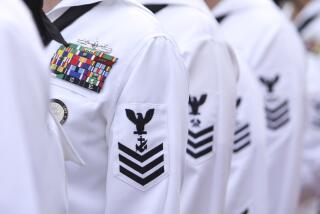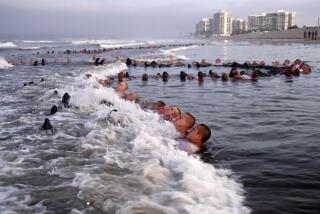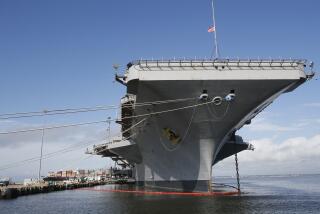What we could learn from the coronavirus outbreak on aircraft carrier Theodore Roosevelt
- Share via
SAN DIEGO — An investigation by the Navy and the Centers for Disease Control and Prevention into the outbreak of the novel coronavirus on board the San Diego-based aircraft carrier Theodore Roosevelt could yield data valuable not just to the military but also to the greater scientific community in the race to better understand the virus, the Navy said.
The Roosevelt has been tied up in Guam for the last month as the virus spread throughout its crew.
More than 17% of the ship’s approximately 4,845 sailors have tested positive for the coronavirus — 856 sailors. A handful of results are still outstanding, the Navy said Friday.
Four sailors are in the hospital at Naval Base Guam. Another, Chief Petty Officer Charles Thacker, 41, died of COVID-19 on April 13.
Since Monday, the Navy has been surveying members of the crew as part of its investigation. The Navy and CDC said previously that they hoped to survey 1,000 sailors, obtaining saliva and blood tests.
Cmdr. Denver Applehans, a spokesman for the Navy Bureau of Medicine and Surgery, said in an email Friday that the service had asked 1,400 sailors to participate. The Navy fell well short of that goal.
“We are very thankful to the roughly 400 crewmembers of the USS Theodore Roosevelt who provided specimens for this outbreak investigation,” Applehans wrote. “It’s worth noting that the USS Theodore Roosevelt’s crew has been impacted by this virus harder than any other military unit and there are many competing demands on the crew to get the ship clean and ready to return to sea. We can’t overemphasize our appreciation for those who did volunteer.”
The goal of the investigation, officials say, is to better understand the behavior of the virus and to apply those lessons to other Navy ships and military units.
The outbreak on the Roosevelt presents an opportunity to understand how the disease spreads in a relatively controlled environment, said Shane Crotty, a virologist and professor in the Division of Vaccine Discovery at the La Jolla Institute for Immunology in San Diego.
“It’s really an outstanding opportunity to learn more,” Crotty said. “That’s the type of scenario — a controlled environment, far fewer variables — it’s the kind of situation epidemiologists love because of the minimization of variables. For my side, we’re very interested in understanding viral immunology — the response [to the virus]. In particular, how that would help vaccine development.”
The development of an effective vaccine for the coronavirus is seen by many as key to getting life around the world back to normal. The La Jolla Institute for Immunology is leading an international effort to collect antibody samples, which are key in vaccine development.
Blood samples from the Roosevelt investigation will be tested at the CDC’s laboratory in Atlanta using the agency’s new serology test, which can identify antibodies and tell researchers whether a person has been exposed to the virus even if they are showing no symptoms.
On the Roosevelt, Applehans said, the rate of asymptomatic sailors testing positive for the virus is on the high end of what the CDC says can be expected in the general population.
“Approximately 50% of the sailors who tested positive so far on the [Theodore Roosevelt] have not shown symptoms of COVID-19,” Applehans said. “The CDC has said that roughly 25% of COVID-19 infections are asymptomatic across all age groups. Given that the sailors are generally younger and healthier than the general population across all age groups, 50% or even slightly above may be appropriate or expected.”
Applehans said the Navy expects to gain more clarity on asymptomatic carriers and virus transmission through its ongoing outbreak investigations.
Among the questions Crotty has is whether asymptomatic people who test positive for the virus develop an immune response — something the CDC’s antibody test might reveal.
“From my area in expertise, for us thinking about vaccine development and immunity, one missing piece is: Do asymptomatic cases develop immune responses or not?” Crotty said. “The blood tests on the sailors should reveal that pretty quickly.”
That immune response — one that effectively fights off the virus — would tell researchers what an effective response looks like.
“Right now there are over 80 different vaccine candidates,” Crotty said. “Once you have information in hand on what a good immune response looks like, it can help point out what vaccine strategy works. That’s really valuable information — they’re going to have very high quality data about true asymptomatic cases.”
On the Roosevelt, and unlike anywhere else with an outbreak, 100% of those potentially exposed to the virus have been tested. Although not all of the crew participated in the Navy and CDC’s investigation, and the goal is not specifically for vaccine development, the Navy is hopeful its results are useful.
“What this outbreak investigation will provide is some basic information about exposure to the virus aboard the ship and the development of antibodies from that exposure,” Applehans said. “We hope it is useful in providing some additional information on how this virus is transmitted.”
In addition to the blood and saliva samples taken from sailors, officials also had volunteers fill out surveys to track their locations on board the ship.
The Navy’s surgeon general, Rear Adm. Bruce Gillingham, said recently that one of the goals of the investigation is to determine how much the virus spread without sailors showing symptoms.
“Because of the pre-symptomatic transmission, we believe that it probably passed through the ship quite freely and was initially unrecognized,” Gillingham said.
The Roosevelt pulled into Guam on March 28 as the virus spread out of control among its crew. It is the largest outbreak of the virus in the U.S. military.
The first two cases were found among two members of the ship’s air wing, a Navy official told the San Diego Union-Tribune. However, because the two cases came to light 15 days after a port visit to Vietnam, Gillingham could not say how the virus got on board.
“The intent of investigation is not to get to the source; it’s to better understand the behavior of the virus going forward,” he said.
Other factors the Navy is learning about the virus came to light recently, as the service reported that some quarantined sailors tested positive for the virus more than 14 days after testing negative.
Experts point to the virus’ long incubation period as one of the key factors making its spread difficult to slow.
Though the Navy’s interests in the investigation lean more toward getting back to sea and conducting operations, Applehans said the CDC will share its data with researchers on the civilian side as well.
“Our partners at CDC will share that information with the broader scientific community as is useful,” Applehans said. “We won’t know for sure until the specimens are processed and the data analyzed, but everything we can learn about this new virus is useful and contributes to the larger body of scientific knowledge that will increase our understanding of how we can prevent, treat and mitigate COVID-19.”
The Navy expected its survey of the crew to finish Friday. Results from the CDC are not due for at least one month.
Dyer writes for the San Diego Union-Tribune.
More to Read
Sign up for Essential California
The most important California stories and recommendations in your inbox every morning.
You may occasionally receive promotional content from the Los Angeles Times.











